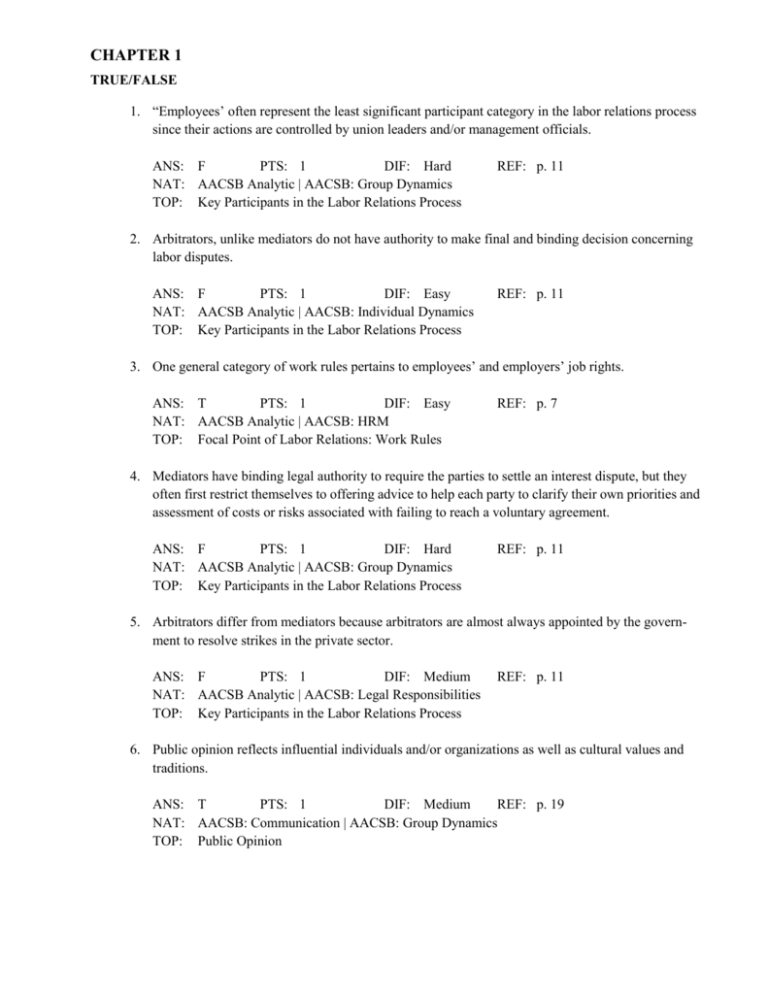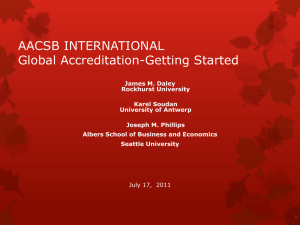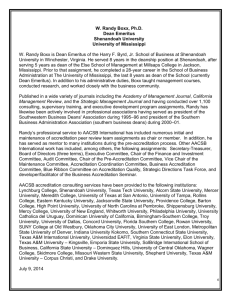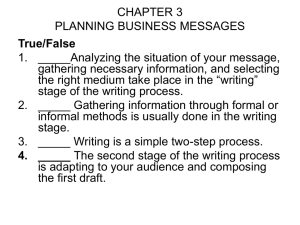chapter 1
advertisement

CHAPTER 1 TRUE/FALSE 1. “Employees’ often represent the least significant participant category in the labor relations process since their actions are controlled by union leaders and/or management officials. ANS: F PTS: 1 DIF: Hard NAT: AACSB Analytic | AACSB: Group Dynamics TOP: Key Participants in the Labor Relations Process REF: p. 11 2. Arbitrators, unlike mediators do not have authority to make final and binding decision concerning labor disputes. ANS: F PTS: 1 DIF: Easy NAT: AACSB Analytic | AACSB: Individual Dynamics TOP: Key Participants in the Labor Relations Process REF: p. 11 3. One general category of work rules pertains to employees’ and employers’ job rights. ANS: T PTS: 1 DIF: Easy NAT: AACSB Analytic | AACSB: HRM TOP: Focal Point of Labor Relations: Work Rules REF: p. 7 4. Mediators have binding legal authority to require the parties to settle an interest dispute, but they often first restrict themselves to offering advice to help each party to clarify their own priorities and assessment of costs or risks associated with failing to reach a voluntary agreement. ANS: F PTS: 1 DIF: Hard NAT: AACSB Analytic | AACSB: Group Dynamics TOP: Key Participants in the Labor Relations Process REF: p. 11 5. Arbitrators differ from mediators because arbitrators are almost always appointed by the government to resolve strikes in the private sector. ANS: F PTS: 1 DIF: Medium NAT: AACSB Analytic | AACSB: Legal Responsibilities TOP: Key Participants in the Labor Relations Process REF: p. 11 6. Public opinion reflects influential individuals and/or organizations as well as cultural values and traditions. ANS: T PTS: 1 DIF: Medium REF: p. 19 NAT: AACSB: Communication | AACSB: Group Dynamics TOP: Public Opinion 7. Work rules, while complex in nature, have a common dimension since the all pertain to compensation for work performed. ANS: F PTS: 1 DIF: Medium NAT: AACSB Analytic | AACSB: HRM TOP: Focal Point of Labor Relations: Work Rules REF: p. 7 8. Public opinion of institutions in general is low in the United States. ANS: T PTS: 1 DIF: Medium NAT: AACSB Ethics | AACSB: Environmental Influence TOP: Public Opinion REF: p. 21 9. Although union leaders are usually elected by the members, members and leaders do not completely agree on bargaining priorities. ANS: T PTS: 1 DIF: Medium NAT: AACSB Analytic | AACSB: Group Dynamics TOP: Key Participants in the Labor Relations Process REF: p. 25 10. Public opinion, while a potentially powerful influence, pertains only to the first phase of the labor relations process, particularly union organizing drives. ANS: F PTS: 1 DIF: Hard REF: p. 21 NAT: AACSB Analytic | AACSB: Environmental Influence TOP: Public Opinion 11. Negotiation of the labor agreement occurs during the third phase of the labor relations process. ANS: F PTS: 1 DIF: Easy NAT: AACSB Analytic | AACSB: HRM TOP: Phases in the Labor Relations Process REF: p. 4 12. Union membership in the United States has shown a steady decline as a proportion of the total labor force (i.e., comprising all employed persons 16 years of age or older). ANS: T PTS: 1 DIF: Medium NAT: Phases in the Labor Relations Process TOP: Public Opinion REF: p. 24 13. The employees’ age, race, and ethnic background might influence whether particular work rules are found in the labor agreement. ANS: T PTS: 1 DIF: Medium NAT: AACSB Analytic | AACSB: Individual Dynamics TOP: Key Participants in the Labor Relations Process REF: p. 6 14. Union density is one measure of relative union strength or potential influence. ANS: T PTS: 1 DIF: Easy NAT: AACSB Reflective Thinking | AACSB: Strategy TOP: Union Membership REF: p. 24 15. Work rules in organizations where employees are unrepresented (no union) are typically not determined unilaterally by management. ANS: F PTS: 1 DIF: Easy NAT: AACSB Analytic | AACSB: HRM TOP: Phases in the Labor Relations Process REF: p. 6 16. Significant employee pension and health care benefit gains under union contracts are now referred to as “high legacy costs” by unionized employers. ANS: T PTS: 1 DIF: Easy NAT: AACSB: Communication | AACSB: HRM TOP: Union Membership REF: p. 24 17. “Employees” need to be viewed as a separate category of participants since they can have loyalties to both the employer and union organizations. ANS: T PTS: 1 DIF: Medium NAT: AACSB Analytic | AACSB: Individual Dynamics TOP: Key Participants in the Labor Relations Process REF: p. 12 18. Many of today’s fastest growing occupations are on opposite ends of the level of education and skills required for effective job performance. ANS: T PTS: 1 DIF: Medium REF: p. 26 NAT: AACSB Analytic | AACSB: Environmental Influence TOP: Union Membership 19. Regarding the management organization, labor relations managers and representatives are often found at the corporate, divisional, and plant levels. ANS: T PTS: 1 DIF: Medium NAT: AACSB Analytic | AACSB: HRM TOP: Key Participants in the Labor Relations Process REF: p. 9 20. The growth in part-time employment also has a small, but significant, positive impact on union density. ANS: F PTS: 1 DIF: Easy NAT: AACSB Analytic | AACSB: Group Dynamics TOP: Union Membership REF: p. 24 MULTIPLE CHOICE 1. __________ are third-party neutrals hired by the union and management officials to make a final and binding decision on a disputed issue. a. Arbitrators b. Mediators c. Retired company presidents d. all of the above e. none of these ANS: A PTS: 1 DIF: Easy NAT: AACSB Analytic | AACSB: Group Dynamics TOP: Key Participants in the Labor Relations Process REF: p. 11 2. “Technology” includes: a. tasks to be performed. b. pace of work. c. characteristics of the work environment. d. all of these. e. characteristics of the work environment and tasks to be performed. ANS: D PTS: 1 DIF: Medium REF: p. 16 NAT: AACSB Analytic | AACSB: Environmental Influence TOP: State of the Economy: National, Industrial, and Firm-Specific Indicators 3. The “labor relations process” occurs when: a. government dictates labor-management activities. b. historical aspects of organized labor affect current decision. c. management and the exclusive bargaining agent (the union) engage in the joint determination and administration of work rules. d. privately held companies go public. e. unions find international affiliations. ANS: C PTS: 1 DIF: Medium NAT: AACSB Analytic | AACSB: Group Dynamics TOP: Phases in the Labor Relations Process REF: p. 5 4. Technology is an external variable that influences the development of work rules. Which of the following represent a dimension of technology? a. characteristics of the work environment and the tasks to be performed b. equipment used in operation c. information exchange d. the pace and scheduling of work e. all of the above ANS: E PTS: 1 DIF: Hard REF: p. 16 NAT: AACSB Analytic | AACSB: Environmental Influence TOP: State of the Economy: National, Industrial, and Firm-Specific Indicators 5. Which of the following “state of the economy” factors is likely to occur? a. Less union pressure for cost-of-living clauses in inflationary times. b. More construction union pressure to protect against layoffs if interest rates rise. c. Unions will be more likely to accept bargaining concessions during unfavorable economic times. d. all of these e. More construction union pressure to protect against layoffs if interest rates rise and unions will be more likely to accept bargaining concessions during unfavorable economic times. ANS: D PTS: 1 DIF: Hard REF: p. 13 NAT: AACSB Reflective Thinking | AACSB: Environmental Influence TOP: State of the Economy: National, Industrial, and Firm-Specific Indicators 6. Management purchases of automated equipment: a. can reduce the number and/or skills of employees in the supermarket industry. b. precipitated a strike at AT&T. c. has been encouraged by the tremendous success of the U.S. Postal Service’s automated experience with bar codes. d. is currently at a higher rate than that found in Japan. e. all of these ANS: A PTS: 1 DIF: Medium REF: p. 19 NAT: AACSB Technology | AACSB: Information Technologies TOP: State of the Economy: National, Industrial, and Firm-Specific Indicators 7. The “focal point” of labor relations represents: a. the government. b. work rules. c. public opinion. d. union and management officials. e. all of these ANS: B PTS: 1 DIF: Medium NAT: AACSB Analytic | AACSB: Group Dynamics TOP: Focal Point of Labor Relations: Work Rules REF: p. 5 8. The negotiation of compensation for and number of intervals for bus drivers reflects which technological component? a. Tasks to be performed. b. Equipment used. c. The pace of work. d. none of these e. all of these ANS: C PTS: 1 DIF: Medium REF: p. 19 NAT: AACSB Analytic | AACSB: Environmental Influence TOP: State of the Economy: National, Industrial, and Firm-Specific Indicators 9. “Probationary work periods” would be most desired by management when the labor market: a. has a low unemployment rate and a low number of unskilled employees. b. has a low unemployment rate. c. has a low number of unskilled employees d. has a high unemployment rate and many skilled employees. e. has a high number of unskilled employees. ANS: E PTS: 1 DIF: Medium REF: p. 14 NAT: AACSB Reflective Thinking | AACSB: Environmental Influence TOP: State of the Economy: National, Industrial, and Firm-Specific Indicators 10. U.S. unions believe that “fair trade” will: a. serve to raise the living standards of workers in their own countries. b. ensure that domestic companies can compete effectively in global markets. c. reduce the labor cost advantage of moving work done by U.S. workers. d. fostering more cooperation with foreign-based labor organizations. e. all of these ANS: E PTS: 1 DIF: Medium NAT: AACSB Ethics | AACSB: Environmental Influence TOP: International Forces REF: p. 18 11. One union estimate found that management consultants hired to counter a union organizing campaign were: a. ridiculed by employees who overwhelmingly voted for union representation. b. seldom if ever used by corporations. c. involved in 75 percent of the union organizing campaigns. d. none of these e. all of these ANS: C PTS: 1 DIF: Medium NAT: AACSB Analytic | AACSB: Individual Dynamics TOP: Key Participants in the Labor Relations Process REF: p. 11 12. When the North American Free Trade Act (NAFTA) was passed, it: a. substantially lowered the wages of Mexican employees, such as truck drivers, in comparison to their U.S. counterparts. b. contained a 25-year phase-in to increase tariffs between Canada, Mexico, and the U.S. c. was unsuccessfully opposed by organized labor. d. all of these e. contained a 25-year phase-in to increase tariffs between Canada, Mexico, and the U.S. and substantially lowered the wages of Mexican employees, such as truck drivers, in comparison to their U.S. counterparts. ANS: C PTS: 1 DIF: Medium REF: p. 18 NAT: AACSB Analytic | AACSB: Environmental Influence TOP: State of the Economy: National, Industrial, and Firm-Specific Indicators 13. Work rules: a. must be specific in nature. b. reflect the dynamic nature of labor management relationships and are sometimes applicable to many occupations. c. reflect the dynamic nature of labor management relationships and must be specific in nature. d. are sometimes applicable to many occupations. e. reflect the dynamic nature of labor management relationships. ANS: B PTS: 1 DIF: Hard NAT: AACSB Analytic | AACSB: Group Dynamics TOP: Focal Point of Labor Relations: Work Rules REF: p. 4 14. An analysis of 40 years of The New York Times columns concerning labor unions found that the frequency of strikes has: a. reached a record high. b. been exaggerated. c. remained relatively constant from one year to the next. d. can’t be determined since the required statistics were not kept until 1985. e. widely fluctuated from one year to the next. ANS: B PTS: 1 DIF: Medium REF: p. 20 NAT: AACSB Analytic | AACSB: Environmental Influence TOP: Public Opinion 15. The sequence of the labor relations process is: a. random. b. unpredictable. c. independent. d. cumulative. e. unpredictable and random. ANS: D PTS: 1 DIF: Hard REF: p. 6 NAT: AACSB Reflective Thinking | AACSB: Group Dynamics TOP: Phases in the Labor Relations Process 16. The mass media: a. generally have a pro labor bias and helped bring several businesses to Peoria, Illinois, by publicizing labor management cooperation at Caterpillar. b. often serve as a generator and conduit of community opinion and helped bring several businesses to Erie, PA by publicizing labor management cooperation at Caterpillar. c. helped bring several businesses to Erie, PA, by publicizing labor management cooperation at Caterpillar. d. often serve as a generator and conduit of community opinion. e. generally have a pro labor bias. ANS: D PTS: 1 DIF: Medium REF: p. 19 NAT: AACSB: Communication | AACSB: Group Dynamics TOP: Public Opinion 17. The labor relations process consists of _______ basic phase(s). a. 1 b. 2 c. 3 d. 4 e. 5 ANS: C PTS: 1 DIF: Easy NAT: AACSB Analytic | AACSB: Group Dynamics TOP: Phases in the Labor Relations Process REF: p. 4 18. Union officials seek to enhance public opinion by: a. getting organized labor’s positive message out to the community and forming alliances with various groups in the community. b. monitoring and reacting to negative comments made in the media. c. forming alliances with various groups in the community. d. getting organized labor’s positive message out to the community. e. all of these ANS: E PTS: 1 DIF: Hard REF: p. 20 NAT: AACSB Analytic | AACSB: Environmental Influence TOP: Public Opinion 19. The product market: a. is where the company either sells its product or purchases key elements for its manufacture or can make management more vulnerable. b. is basically an irrelevant influence on the labor relations process and is where the company either sells it product or purchases key elements for its manufacture. c. is basically an irrelevant influence on the labor relations process. d. can make management more vulnerable. e. is where the company either sells it product or purchases key elements for its manufacture. ANS: A PTS: 1 DIF: Hard REF: p. 15 NAT: AACSB Analytic | AACSB: Environmental Influence TOP: State of the Economy: National, Industrial, and Firm-Specific Indicators 20. The decline in union membership has been attributed to: a. political and legal conditions governing the workplace. b. structural changes in the labor force. c. improved management practices in organizations. d. all of these e. none of these adequately explain the decline in union membership. ANS: D PTS: 1 DIF: Medium REF: p. 22 NAT: AACSB Analytic | AACSB: Environmental Influence TOP: Union Membership 21. The federal government’s role in private sector collective bargaining activities is basically: a. illegal. b. direct and prohibited. c. direct. d. prohibited. e. indirect. ANS: E PTS: 1 DIF: Medium REF: p. 11 NAT: AACSB Analytic | AACSB: Environmental Influence TOP: Key Participants in the Labor Relations Process








